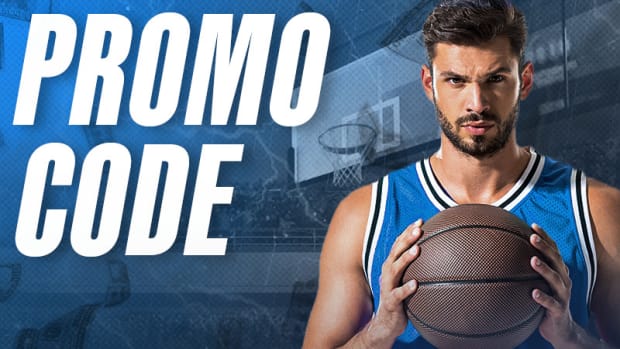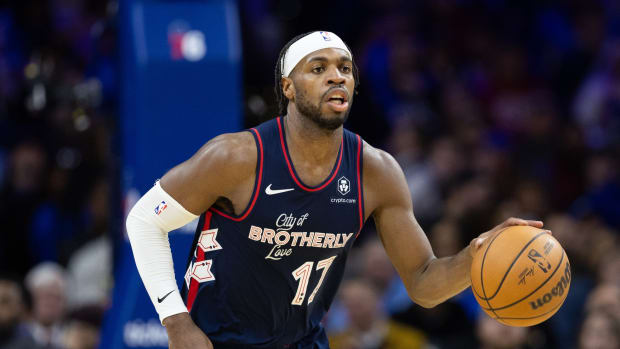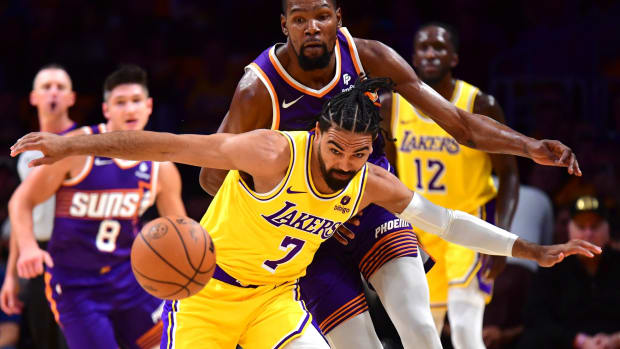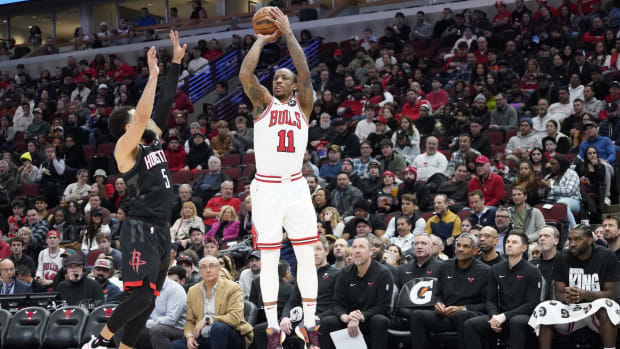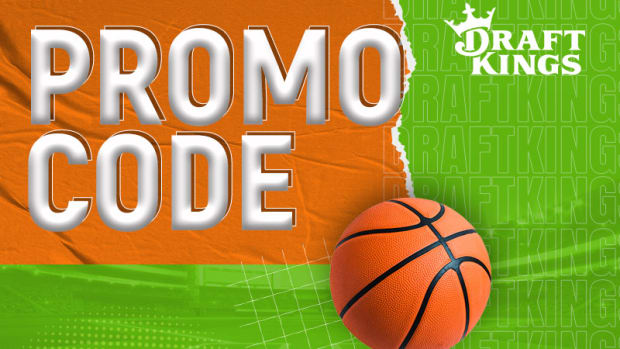2017 NBA Draft Grades: Pick-By-Pick Analysis
The 2017 NBA draft is in the books. Let's hand out some grades.
For your entertainment pleasures, The Crossover broke down each pick from the first round and provided grades and analysis. From Markelle Fultz at No. 1 to Josh Hart at No. 30, The Crossover's Jeremy Woo graded each pick in real time and dished on the value and fit.
How did your team do? How angry will you be when you see our grades? Let's dive in and find out.
2017 NBA draft order: First round
1. Philadelphia 76ers: Markelle Fultz, Washington
It’s too early to jump to sweeping, dynastic conclusions, but the Sixers finally found the deal they wanted and got their guy. Fultz was the top prospect in the draft in the eyes of many (SI included), and should pair effectively with Ben Simmons and Joel Embiid going forward. We’ll see which draft assets the Sixers wind up losing in the long run, but it felt like the right time for Philly to strike. The Sixers will be one of the league’s most intriguing teams to follow next season, with Fultz at the heart of an all-time extended rebuild. Whatever happens next, it’s a win for now. Grade: A
2. Los Angeles Lakers: Lonzo Ball, UCLA
The Real Balls of Los Angeles is, well, real. The Lakers looked at Josh Jackson and De’Aaron Fox and came back to Ball. Pound for pound as prospects, the three aren’t far apart, but when it comes to philosophical fit, Ball was the clear choice. He’ll benefit from Magic Johnson’s tutelage and Luke Walton’s uptempo offense and have a great opportunity to be a difference-maker. As L.A. angles to land established stars, Ball’s development will be critical. He should be up for the task. LaVar, too. Grade: A
3. Boston Celtics: Jayson Tatum, Duke
Boston felt good about the decision to move down to 3, opted not to add to a crowded backcourt and saw Tatum as a better fit than Josh Jackson here. He’s one of the draft’s most talented offensive players and should add a necessary dimension to its frontcourt in time. The Celtics may have bigger designs this summer and could potentially move this pick, but if they keep Tatum, they should still feel good. He has a chance to end up the best scorer in this class when it’s all said and done. Grade: A–
4. Phoenix Suns: Josh Jackson, Kansas
There was speculation the Suns could either trade this pick or pair De’Aaron Fox with Devin Booker here, but the Jackson selection addresses a more immediate need. It makes a lot of sense given the young core Phoenix continues to assemble. Jackson will immediately provide toughness and help improve the Suns’ defense. Fox was surely tempting, but the thought of Jackson and Devin Booker running on the wings is tantalizing. Grade: A
5. Sacramento Kings: De'Aaron Fox, Kentucky
The Kings coveted Fox throughout the predraft process and got their man at No. 5. He’s exactly the building block Sacramento needs and was the best prospect left on the board. Fox is one of the fastest players in the draft with the ball in his hands, could become a high-level defender at his position and has star potential if his jump shot improves. This long, winding rebuild just got a lot more legitimate. Grade: A
6. Orlando Magic: Jonathan Isaac, Florida State
Orlando was rumored to have promised Isaac at this spot, and rolling the dice on his long-term potential makes a lot of sense for the Magic as they begin to chart course with Jeff Weltman and John Hammond running the show. Isaac had a case as high as the third pick (and in a different year would surely have gone higher) but comes with more risk than the players selected before him given his slight frame and inconsistent play as a freshman for Florida State. That said, his best-case scenario would give the Magic a strong piece to build around, as versatile, tall front-court shooters don’t come along every day. Orlando doesn’t immediately address a need with this selection, but the Isaac pick is a clear indication of the Magic’s timeframe. Grade: A-
7. Chicago Bulls: Lauri Markkanen, Arizona
The Timberwolves made this pick for the Bulls in a deal for Jimmy Butler. The returns on that trade are Kris Dunn, Zach LaVine and this selection, but the Markkanen selection is a questionable one for Chicago by any measure. Although his considerable shooting ability at 7’0” gives him plenty of room to develop as a scorer, Markkanen’s all-around skill set needs a lot of work. There are concerns that his defensive struggles could seriously limit his upside. The Bulls weren’t looking to address a big need here, and eliminating that variable there were better prospects available at this spot. Chicago rolled the dice, and surrendered its best player in the process. It’s a tough sell. Grade: C+
8. New York Knicks: Frank Ntilikina, France
There was a lot of talk about the Knicks’ affection for Ntilikina, who’s considered the top overseas prospect in this draft and now the highest-drafted French player in league history. New York needed to address its backcourt and did so here, although high-scoring and arguably stronger options Dennis Smith and Malik Monk were available. The Knicks have had a strong run drafting internationally in recent years, so they’ve earned a bit of trust, but the 18-year-old Ntilikina has a long way to go and will face a lot of pressure immediately. At the very least, fans can take solace in the fact Kristaps Porzingis appears to be staying put. Grade: B
9. Dallas Mavericks: Dennis Smith Jr., NC State
Dallas has been in search of a franchise point guard for a long time, and hopes Smith will be that. He’s an explosive athlete and talented scorer who can make plays off the dribble and comes with a ton of upside. This is great value for the Mavericks, who gain a legitimate long-term asset as they continue to prepare for the post-Dirk era. In a weaker draft, Smith might have been a top-five talent. Grade: A
10. Portland Trail Blazers: Zach Collins, Gonzaga
It made little sense for the cap-starved Blazers to use all three of their first-round selections. Portland sent Nos. 15 and 20 to Sacramento for this pick, and directly address a need with Collins, perhaps the top defensive big man in this class. There’s plenty of reason to be high on him, despite his limited playing time as a freshman, and teams believe he can become a strong jump shooter and rim protector at the next level. The Blazers will hope he’s the solution in the middle to compliment Damian Lillard and C.J. McCollum sooner rather than later. It’s a shrewd move by GM Neil Olshey. Grade: A
Meeting Markelle Fultz: A Day With The NBA's (Likely) No. 1 Pick
11. Charlotte Hornets: Malik Monk, Kentucky
Although Monk fell out of the Top 10, he wasn’t bound to fall very far. Charlotte planned to find a partner for Kemba Walker at this spot and also considered Donovan Mitchell. Monk’s the higher-upside play of the two, and presented a strong value opportunity here. He’s one of the draft’s top shooters, and could eventually be more than that thanks to his athletic ability. His defensive fit alongside Walker is a little questionable, and the Hornets will be giving up size, but they’ll certainly be more exciting. This was the right choice. Grade: A–
12. Detroit Pistons: Luke Kennard, Duke
The Pistons were hoping someone would fall to No. 12 from the top group of prospects, but will be happy to bring in Kennard, who elevated his stock over the past month and is one of the draft’s top three-point shooters. Detroit needed floor-spacers, and gets a tough, intelligent player who should be solid, if not spectacular. Based on what was available, Kennard was a strong choice. Grade: B+
13. Utah Jazz: Donovan Mitchell, Louisville
The Nuggets sent this pick to the Jazz in exchange for Trey Lyles and pick No. 24. Mitchell was the top available guard, and fills a potential hole for Utah with George Hill potentially headed elsewhere. Given that Gordon Hayward’s future is also unclear, taking a swing on an upside pick like Mitchell makes a lot of sense. He’s hyper-athletic and could become a dynamic, versatile player at either guard spot. Lyles showed some promise, but the Jazz acted decisively here for good reason. Grade: A-
14. Miami Heat: Bam Adebayo, Kentucky
The Heat were in a tricky position at this spot, which is where value in the draft begins to get cloudy. Adebayo’s stock was up and down during the college season, but he impressed teams in the predraft process and gathered steam thanks to a bankable skill set as an energy big with defensive mobility. Miami ultimately preferred the safety of this selection over a slew of other bigs on the board, and he should be a nice rotational player. Grade: B+
15. Sacramento Kings: Justin Jackson, North Carolina
The Kings made a nice decision to move down with no clear choice at No. 10, but this feels a little high for Jackson. The idea of him as a shooter and defender remains a little stronger than his actual skill level at this stage. He’s not an above-the-rim athlete, which many saw as a limiting factor for his best-case scenario. It’s not sexy, but credit Sacramento for making a relatively conservative pick for once. It’s conceivable the Kings were concerned about him going before their next pick at No. 20. Grade: B-
16. Minnesota Timberwolves: Justin Patton, Creighton
Patton is a high-upside prospect who makes a lot of sense for Minnesota here. When you consider this selection in the context of the Wolves’ extremely favorable move to add Jimmy Butler, getting this pick back and landing a player with around as much long-term potential as any of the assets Minnesota surrendered is a big win. Patton has a lot of talent, particularly on offense, and will not need to be rushed thanks to the presence of Karl-Anthony Towns. This is the perfect risk for the Wolves to take. Grade: A–
17. Milwaukee Bucks: D.J. Wilson, Michigan
Every pick in this range of the draft is a risk, and D.J. Wilson’s potential as a well-rounded role player helped him rise to the top of the crop. He’s a late-bloomer who didn’t have a large sample size of quality production (and was highly inconsistent at times), but a lot of teams were extremely high on his ability to defend multiple positions and shoot the three. He’s a good athlete with enviable size for a stretch-four. Milwaukee has assembled an extremely intriguing collection of talent, and Wilson is a strong long-term fit around Giannis Antetokounmpo. Grade: A–
18. Indiana Pacers: T.J. Leaf, UCLA
The Pacers were picking in a tough spot here, with several of the higher-upside prospects going immediately ahead of them. Given Paul George’s murky future, Indiana had to draft the best player available, and Leaf is a pretty safe selection with a clear fit in the NBA. He’s athletic and highly skilled on offense and should give the Pacers scoring and allow them to spread the floor. They’ll hope his defensive shortcomings are mitigated by Myles Turner’s rim protection. He looks like a bankable asset, and that’s the smart choice for Indiana. Grade: B+
19. Atlanta Hawks: John Collins, Wake Forest
Collins’s stock took a bit of a hit down the final stretch of predraft. Some teams were concerned about his maturity, readiness for the NBA and commitment to playing defense. He’s a good prospect and had a productive season, but some additional development is required. If he pans out, the Hawks may have nabbed some value here, but it’s fair to wonder a bit whether he was the best prospect on the board. Long rumored to be taking a big here, Atlanta fills a need with Paul Millsap potentially packing his bags this summer. Grade: B–
20. Sacramento Kings: Harry Giles, Duke
Giles was once a potential No. 1 draft pick, but a run of serious knee injuries sapped his draft stock and landed him here with Sacramento following a trade. His camp declined an invitation to the draft’s green room last-minute, likely concerned about his wide range of outcomes given the injury risk. A guaranteed first-round deal is a big win for Giles. The Kings are taking a big swing here, and it’s completely justifiable given the potential value. Props for the ballsy thinking, and perhaps going safe with Justin Jackson at No. 15 mitigates the risk. Grade: B
Who Wants To Bet On De'Aaron Fox?
21. Oklahoma City Thunder: Terrance Ferguson, Australia
Ferguson shut down his workouts late in the predraft process and was believed to have a promise somewhere in the first round. The Thunder may have been that promise. OKC takes a nice upside swing here in a draft where three-point shooting is at a premium. Ferguson is still raw after a year of pro ball in Australia, but can really shoot it and brings some added athleticism on the wing. He needs time to develop his game off the dribble and put on weight. The Thunder could have gone a more win-now route for Russell Westbrook’s sake, but this is a measured long-term play on one of the higher-upside players available. Grade: B+
22. Brooklyn Nets: Jarrett Allen, Texas
Everyone was expecting the Nets to take a big risk here, and that’s exactly what they did. Allen has impressive physical tools, but has a lot of learning to do. He improved over the course of the season at Texas, which helps his cause a little bit, but scouts were mixed about whether or not Allen would ever tap into his full potential. It’s smart in theory and certainly justifiable, but there’s equal reason to be skeptical. The good news is that Brooklyn can afford to wait and see. Grade: B–
23. Toronto Raptors: OG Anunoby, Indiana
There were mixed reports on the status of Anunoby’s ACL recovery, and concerns about his long-term health led to his slide in the draft. This is nice value for the Raptors, accordingly. Anunoby may miss significant time next season, but he could be a terrific defensive player and gives Toronto a great deal of upside if he returns to full health. He needs to improve his offensive skills, as he’s somewhat limited as a scorer, but has promise as a jump shooter and he’s a very good athlete. His insane length could make him a terrifying perimeter stopper. Grade: B+
24. Denver Nuggets: Tyler Lydon, Syracuse
The Nuggets moved down in the draft from No. 13 in a deal with the Jazz and take Lydon here, adding some size and shooting to their young roster. There’s a wide difference of opinion on him. Some see a legitimate big man who can shoot the three, others see an inconsistent player who may not be mobile or springy enough to cut it in the NBA. He has a clear path to becoming a role player, but ultimately, this is a bit underwhelming. Denver also got Trey Lyles in this deal with Utah, who plays the same position. It’s a little bit confusing. Grade: C–
25. Philadelphia 76eras: Anzejs Pasecniks, Latvia
This pick moved from Orlando to Philadelphia. Pasecniks is a talented 7-footer with upside the Sixers can keep overseas for a couple of seasons if need be. He has some shooting potential and gives the Sixers another asset as they rebuild. Grade: B
26. Portland Trail Blazers: Caleb Swanigan, Purdue
The Blazers add another intriguing piece to their frontcourt in Swanigan, who has one of the best stories in the draft and brings a lot of skill and toughness to the next level. He’s undersized and may struggle defensively due to slow feet, but he’s a great passer and rebounder who plays bigger than his size. This is a bit of a gamble, but a worthwhile one for Portland. He could be a unique player if he finds a way to stay on the floor. Grade: B
27. Los Angeles Lakers: Kyle Kuzma, Utah
The Lakers were said to be high on Kuzma and covet his blend of skill and shooting ability. He’s more athletic than several of the other stretch-forward prospects in this range, and has some upside as a role player. He’s not an especially proven prospect and didn’t shoot that well from three at Utah last season, but teams think he can figure it out. If he does, he’s a nice fit for what L.A. is building. Lonzo Ball loves having shooters around him. Grade: B+
28. Utah Jazz: Tony Bradley, North Carolina
This pick is going from the Lakers to the Jazz in exchange for Nos. 30 and 42. The Jazz were one of the teams that loved Bradley and are getting a talented player with upside here, although he’ll need to continue working on his body and expanding his skill level. He should become a nice developmental big for Utah with potential to be a two-way contributor. Grade: A–
29. San Antonio Spurs: Derrick White, Colorado
White was a popular sleeper pick around the league, and he’s a perfect fit for the Spurs. He’s a talented scorer, distance shooter and ball-handler and can play both guard positions, although he’ll need to improve playing off the ball. White’s athleticism could also make him an impactful defender. Some have compared him to former Spurs guard Antonio Daniels, and he could immediately be helpful for San Antonio. Grade: A
30. Los Angeles Lakers: Josh Hart, Villanova
Hart is a nice pickup for the Lakers, who also acquired the No. 42 pick after dealing down from No. 28 with Utah. The Jazz were likely concerned about the Spurs taking Tony Bradley at 29, and the Lakers benefit here. Hart is viewed around the league as an extremely safe pick, as an experienced player who guards multiple positions, makes winning plays and has improved the quality of his jump shot. He gives L.A. another quality young player for its project. Grade: A

































